A Thorough Investigation of the Mechanism of theAntagonistic Effect Between Phosphorus and Basic Oxide-Forming Minerals as Flame Retardants of PolymericComposite Coatings
Abstract
1. Introduction
2. Materials and Methods
2.1. Materials
2.2. Surface Modification of Mg(OH)2
2.3. Compound Sample Preparation
2.4. Characterization and Analysis Methods
3. Results
3.1. Characterization of the PES FR 1304 Matrix
3.2. Characterization of the SA-Modified MDH Filler
3.3. Flame-Retardancy Assessment—Limited Oxygen Index (LOI) and UL94V Test Results
3.4. Sample Thermogravimetric Analysis Results
3.5. Spectroscopic Analysis of TGA-Derived Solid Residues
3.5.1. Analysis of the Solid Residue Collected After the Sample’s Thermal Decomposition at 800 °C
3.5.2. Analysis of the Solid Residue Collected During Sample’s Degradation
3.6. XRD Diffractograms of the Solid Residues at 800 °C
3.7. Scanning Electron Microscopy (SEM) Images
4. Conclusions
Author Contributions
Funding
Institutional Review Board Statement
Informed Consent Statement
Data Availability Statement
Conflicts of Interest
References
- Deshmukh, G.S.; Peshwe, D.R.; Pathak, S.U.; Ekhe, J.D. A study on effect of mineral additions on the mechanical, thermal, and structural properties of poly(butylene terephthalate) (PBT) composites. J. Polym. Res. 2010, 18, 1081–1090. [Google Scholar] [CrossRef]
- Karsli, N.G.; Ozkan, C.; Aytac, A.; Deniz, V. Characterization of poly(butylene terephthalate) composites prepared by using various types of sized carbon fibers. Mater. Des. 2015, 87, 318–323. [Google Scholar] [CrossRef]
- Hastie, J.W.; Bonnell, D.W. Molecular Chemistry of Inhibited Combustion Systems; Report NBSIR 80-2169; National Bureau of Standards: Gaithersburg, MD, USA, 1980.
- Gallo, E.; Braun, U.; Schartel, B.; Russo, P.; Acierno, D. Halogen-free flame retarded poly(butylene terephthalate) (PBT) using metal oxides/PBT nanocomposites in combination with aluminium phosphinate. Polym. Degrad. Stab. 2009, 94, 1245–1253. [Google Scholar] [CrossRef]
- Keshavarzian, A.; Haghighi, M.N.; Taromi, F.A.; Abedini, H. Phosphorus-based flame retardant poly (butylene terephthalate): Synthesis, flame retardancy and thermal behavior. Polym. Degrad. Stab. 2020, 180, 109310. [Google Scholar] [CrossRef]
- Niu, L.; Xu, J.; Yang, W.; Ma, J.; Zhao, J.; Kang, C.; Su, J. Study on the Synergetic Fire-Retardant Effect of Nano-Sb2O3 in PBT Matrix. Materials 2018, 11, 1060. [Google Scholar] [CrossRef] [PubMed]
- Suzanne, M.; Ramani, A.; Ukleja, S.; McKee, M.; Zhang, J.; Delichatsios, M.; Patel, P.; Clarke, P.; Cusack, P. Fire performance of brominated and halogen-free flame retardants in glass-fiber reinforced poly(butylene terephthalate). Fire Mater. 2017, 42, 18–27. [Google Scholar] [CrossRef]
- Lim, K.-S.; Bee, S.-T.; Sin, L.T.; Tee, T.-T.; Ratnam, C.T.; Hui, D.; Rahmat, A.R. A review of application of ammonium polyphosphate as intumescent flame retardant in thermoplastic composites. Compos. Part B Eng. 2016, 84, 155–174. [Google Scholar] [CrossRef]
- Varganici, C.-D.; Rosu, L.; Bifulco, A.; Rosu, D.; Mustata, F.; Gaan, S. Recent advances in flame retardant epoxy systems from reactive DOPO–based phosphorus additives. Polym. Degrad. Stab. 2022, 202, 110020. [Google Scholar] [CrossRef]
- Gibertini, E.; Carosio, F.; Aykanat, K.; Accogli, A.; Panzeri, G.; Magagnin, L. Silica-encapsulated red phosphorus for flame retardant treatment on textile. Surf. Interfaces 2021, 25, 101252. [Google Scholar] [CrossRef]
- Bereska, A.; Kafarski, P.; Bereska, B.; Tkacz, B.; Iłowska, J.; Lenża, J. The application of organophosphorus flame-retardants in epoxy resin. J. Vinyl Addit. Technol. 2015, 23, 142–151. [Google Scholar] [CrossRef]
- Bai, Z.; Tian, Y.; Wang, Z.; Wu, D.; Wang, X.; Yu, J.; Yuan, R.; Li, F. A macromolecular intumescent flame retardant with thermal cross-linking groups for poly(ethylene terephthalate) with enhanced fire safety. Polym. Degrad. Stab. 2024, 225. [Google Scholar] [CrossRef]
- Li, N.; Jiang, G.; Zhou, G. Fire retardant and charring effect of cyclic phenolphthalein (phenylene phosphonate) oligomer on polybutylene terephthalate. RSC Adv. 2015, 6, 2512–2519. [Google Scholar] [CrossRef]
- Goedderz, D.; Weber, L.; Markert, D.; Schießer, A.; Fasel, C.; Riedel, R.; Altstädt, V.; Bethke, C.; Fuhr, O.; Puchtler, F.; et al. Flame retardant polyester by combination of organophosphorus compounds and an NOR radical forming agent. J. Appl. Polym. Sci. 2019, 137, 47876. [Google Scholar] [CrossRef]
- Lv, P.; Wang, Z.; Hu, K.; Fan, W. Flammability and thermal degradation of flame retarded polypropylene composites containing melamine phosphate and pentaerythritol derivatives. Polym. Degrad. Stab. 2005, 90, 523–534. [Google Scholar] [CrossRef]
- Camino, G.; Costa, L.; di Cortemiglia, M.L. Overview of fire retardant mechanisms. Polym. Degrad. Stab. 1991, 33, 131–154. [Google Scholar] [CrossRef]
- Laoutid, F.; Ferry, L.; Lopez-Cuesta, J.M.; Crespy, A. Red phosphorus/aluminium oxide compositions as flame retardants in recycled poly(ethylene terephthalate). Polym. Degrad. Stab. 2003, 82, 357–363. [Google Scholar] [CrossRef]
- Andrikopoulos, K.S.; Bounos, G.; Lainioti, G.C.; Ioannides, T.; Kallitsis, J.K.; Voyiatzis, G.A. Flame Retardant Nano-Structured Fillers from Huntite/Hydromagnesite Minerals. Nanomaterials 2022, 12, 2433. [Google Scholar] [CrossRef]
- Malaysia, M.U.T.; Saidi, M.A.A.; Mazlan, F.S.; Hassan, A.; Rashid, R.A.; Rahmat, A.R. Flammability, Thermal and Mechanical Properties of Polybutylene Terephthalate/Dolomite Composites. J. Phys. Sci. 2019, 30, 175–189. [Google Scholar] [CrossRef]
- Piperopoulos, E.; Scionti, G.; Atria, M.; Calabrese, L.; Proverbio, E. Flame-Retardant Performance Evaluation of Functional Coatings Filled with Mg(OH)2 and Al(OH)3. Polymers 2022, 14, 372. [Google Scholar] [CrossRef] [PubMed]
- Liang, J.; Feng, J.; Tsui, C.; Tang, C.; Liu, D.; Zhang, S.; Huang, W. Mechanical properties and flame-retardant of PP/MRP/Mg(OH)2/Al(OH)3 composites. Compos. Part B Eng. 2015, 71, 74–81. [Google Scholar] [CrossRef]
- Huang, H.; Tian, M.; Liu, L.; Liang, W.; Zhang, L. Effect of particle size on flame retardancy of Mg(OH)2-filled ethylene vinyl acetate copolymer composites. J. Appl. Polym. Sci. 2006, 100, 4461–4469. [Google Scholar] [CrossRef]
- Hale, W.; Pessan, L.; Keskkula, H.; Paul, D. Effect of compatibilization and ABS type on properties of PBT/ABS blends. Polymer 1999, 40, 4237–4250. [Google Scholar] [CrossRef]
- Youn, Y.; Kim, T.W.; Cho, K.; Hong, S.K. Investigation on the Initial Stage of the Dehydration Process in Mg(OH)2 by Density Functional Theory Calculations. ACS Appl. Mater. Interfaces 2024, 16, 23122–23129. [Google Scholar] [CrossRef]
- Ok, J.; Ahn, M.-C. Novel PBT Blends with Magnesium Hydroxide Flame Retardant. 2004. Available online: https://www.analyticalsynthesis.net/about/papers/L3425.pdf (accessed on 24 June 2025).
- Viretto, A.; Sonnier, R.; Taguet, A.; Otazaghine, B.; Ferry, L.; Lopez-Cuesta, J.; Lagrève, C. Thermal degradation of polyesters filled with magnesium dihydroxide and magnesium oxide. Fire Mater. 2015, 40, 445–463. [Google Scholar] [CrossRef]
- Zhang, F.; Zhang, H.; Su, Z. Surface treatment of magnesium hydroxide to improve its dispersion in organic phase by the ultrasonic technique. Appl. Surf. Sci. 2007, 253, 7393–7397. [Google Scholar] [CrossRef]
- Hollingbery, L.; Hull, T. The thermal decomposition of huntite and hydromagnesite—A review. Thermochim. Acta 2010, 509, 1–11. [Google Scholar] [CrossRef]
- Hull, T.R.; Witkowski, A.; Hollingbery, L. Fire retardant action of mineral fillers. Polym. Degrad. Stab. 2011, 96, 1462–1469. [Google Scholar] [CrossRef]
- Hollingbery, L.A. Decomposition and Fire Retardancy of Naturally Occurring Mixtures of Huntite and Hydromagnesite. Ph.D. Thesis, University of Central Lancashire, Preston, UK, 2011. [Google Scholar]
- Hollingbery, L.; Hull, T. The fire retardant behaviour of huntite and hydromagnesite—A review. Polym. Degrad. Stab. 2010, 95, 2213–2225. [Google Scholar] [CrossRef]
- Liao, H.; Liu, Y.; Jiang, J.; Li, J.; Liu, Y. Synergism and antagonism of phosphorus-containing epoxy resin combined with different metal hydroxides. J. Fire Sci. 2016, 34, 3–12. [Google Scholar] [CrossRef]
- Socrates, G. Infrared and Raman Characteristic Group Frequencies: Tables and Charts; John Wiley & Sons: Hoboken, NJ, USA, 2004. [Google Scholar]
- Barańska, H.; Łabudzińska, A.; Terpiński, J. Laser Raman Spectrometry: Analytical Applications; Office of Scientific and Technical Information (OSTI): Oak Ridge, TN, USA, 1987.
- Horrocks, A.R.; Smart, G.; Nazaré, S.; Kandola, B.; Price, D. Quantification of Zinc Hydroxystannate** and Stannate** Synergies in Halogen-Containing Flame-Retardant Polymeric Formulations. J. Fire Sci. 2009, 28, 217–248. [Google Scholar] [CrossRef]
- Lewin, M. Synergism and catalysis in flame retardancy of polymers. Polym. Adv. Technol. 2001, 12, 215–222. [Google Scholar] [CrossRef]
- Mahajan, R.; Prakash, R.; Kumar, S.; Kumar, V.; Choudhary, R.; Phase, D. Surface and luminescent properties of Mg3(PO4)2:Dy3+ phosphors. Optik 2021, 225, 165717. [Google Scholar] [CrossRef]
- Massit, A.; El Yacoubi, A.; Kholtei, A.; El Idrissi, B.C. XRD and FTIR analysis of magnesium substituted tricalcium calcium phosphate using a wet precipitation method. Biointerface Res. Appl. Chem. 2021, 11, 8034–8042. [Google Scholar]
- Sharma, L.; Kakkar, R. Hierarchical Porous Magnesium Oxide (Hr-MgO) Microspheres for Adsorption of an Organophosphate Pesticide: Kinetics, Isotherm, Thermodynamics, and DFT Studies. ACS Appl. Mater. Interfaces 2017, 9, 38629–38642. [Google Scholar] [CrossRef] [PubMed]
- Sompech, S.; Dasri, T.; Thaomola, S. Preparation and Characterization of Amorphous Silica and Calcium Oxide from Agricultural Wastes. Orient. J. Chem. 2016, 32, 1923–1928. [Google Scholar] [CrossRef]
- Ramteke, S.K.; Yerpude, A.N.; Kokode, N.S.; Dhoble, S.J. Optical properties of rare earth-activated Ca3(PO4)2:RE (RE = Eu3+ and Dy3+) phosphors prepared by wet chemical synthesis. Bull. Mater. Sci. 2021, 44, 1–5. [Google Scholar] [CrossRef]
- Nagpure, I.; Shinde, K.; Dhoble, S.; Kumar, A. Photoluminescence characterization of Dy3+ and Eu2+ ion in M5(PO4)3F (M=Ba, Sr, Ca) phosphors. J. Alloy. Compd. 2009, 481, 632–638. [Google Scholar] [CrossRef]
- Zhang, S.; Li, L.; Lv, X. Synthesis and characterization of a novel Mg3(PO4)2 ceramic with low dielectric constant. J. Mater. Sci. Mater. Electron. 2016, 28, 1620–1623. [Google Scholar] [CrossRef]
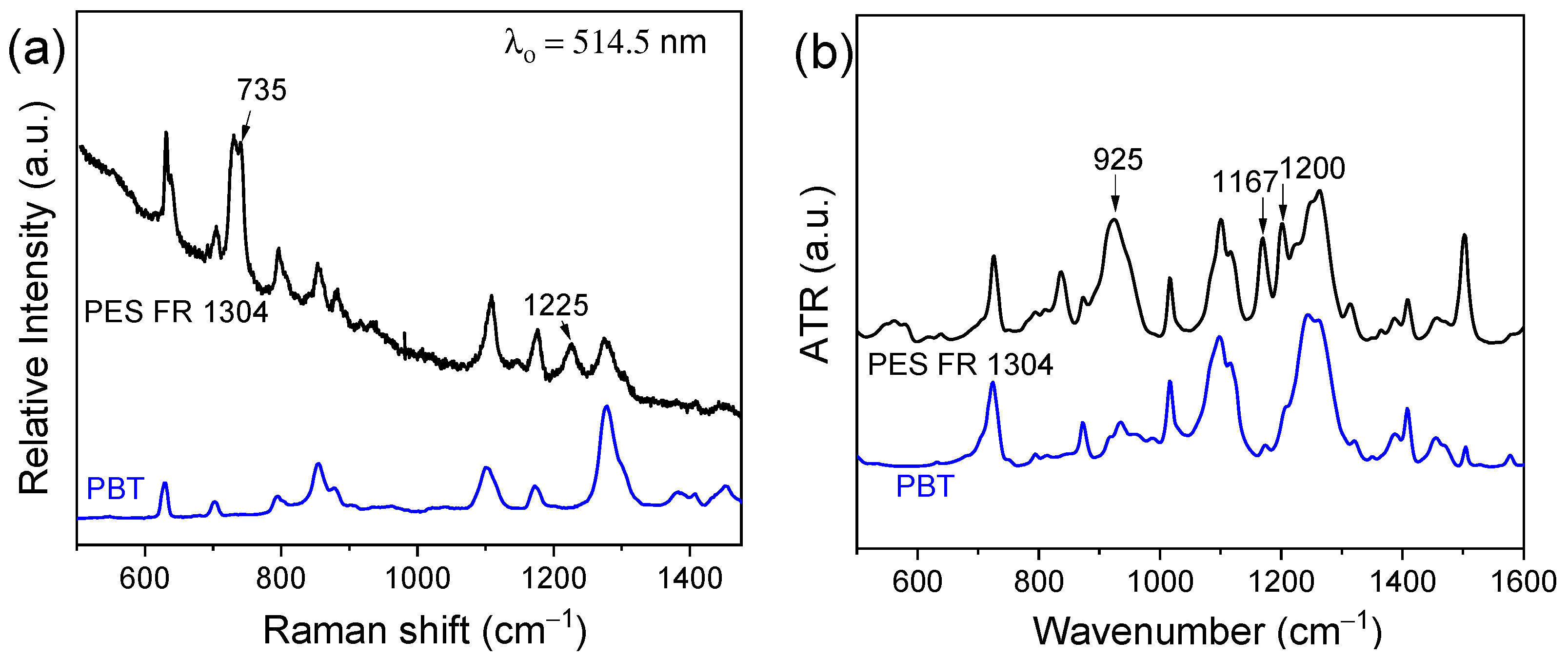

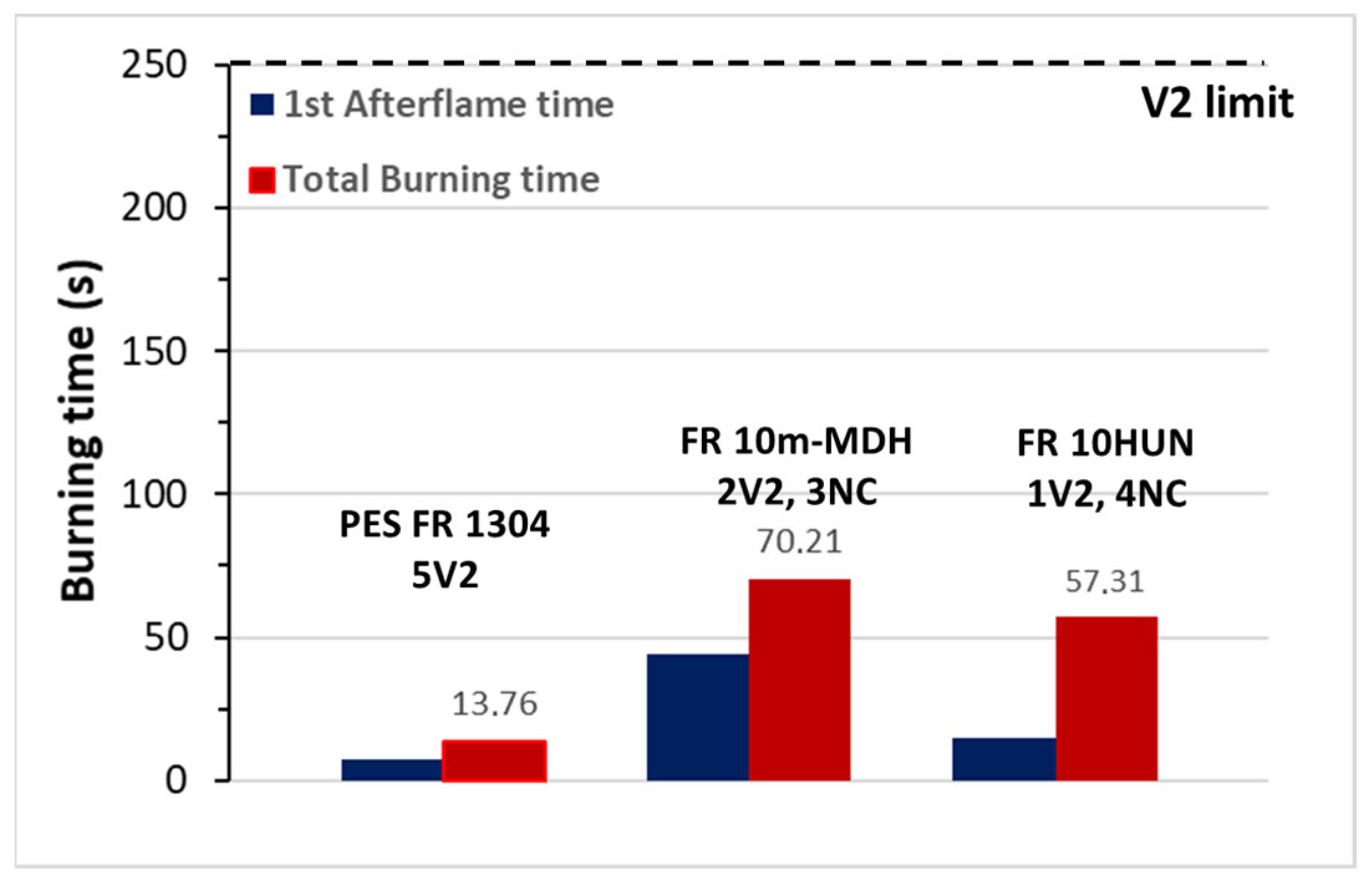
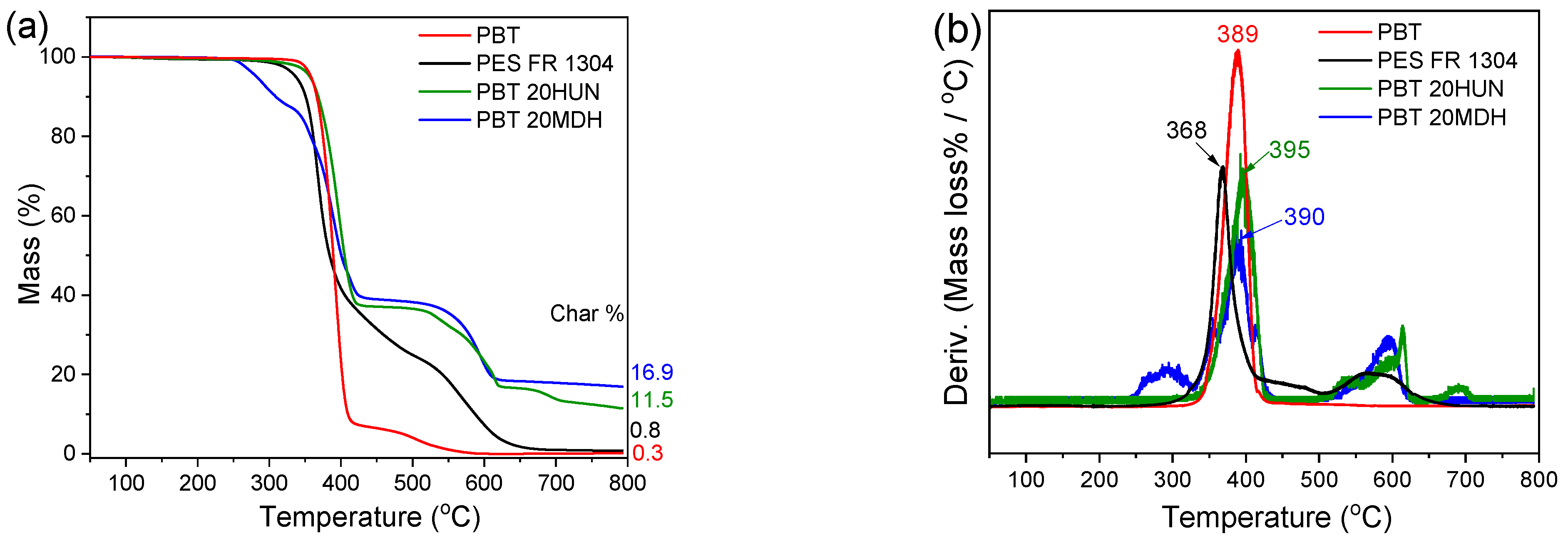
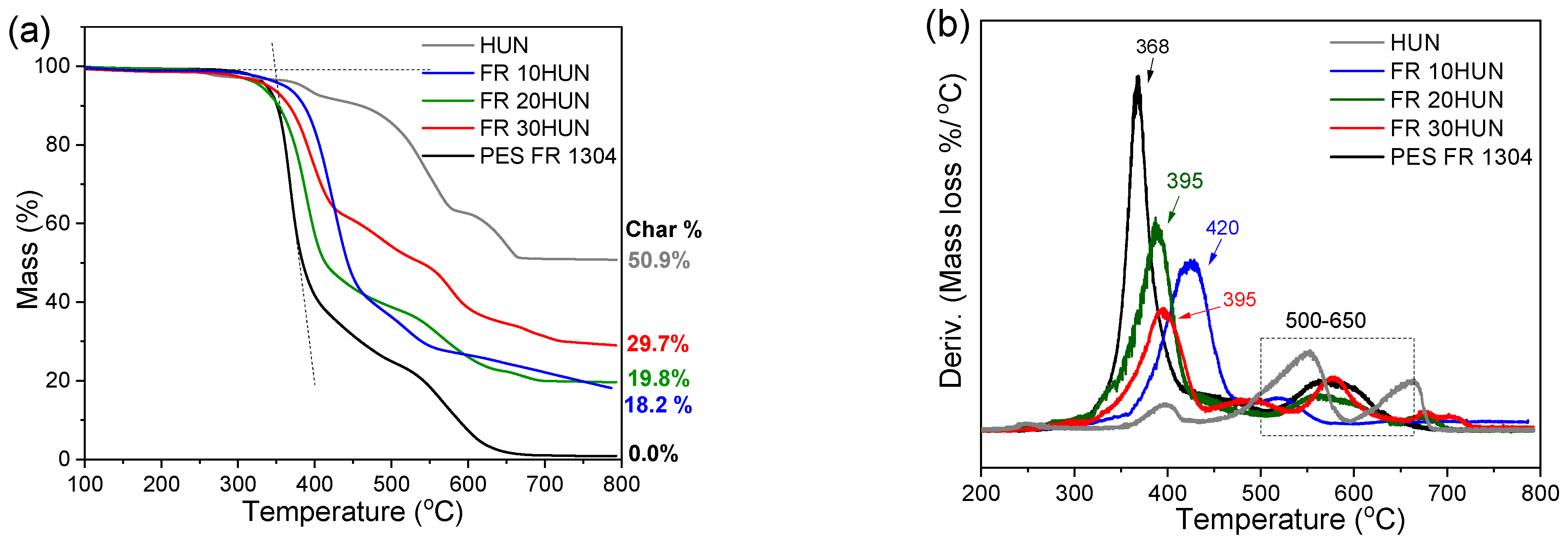
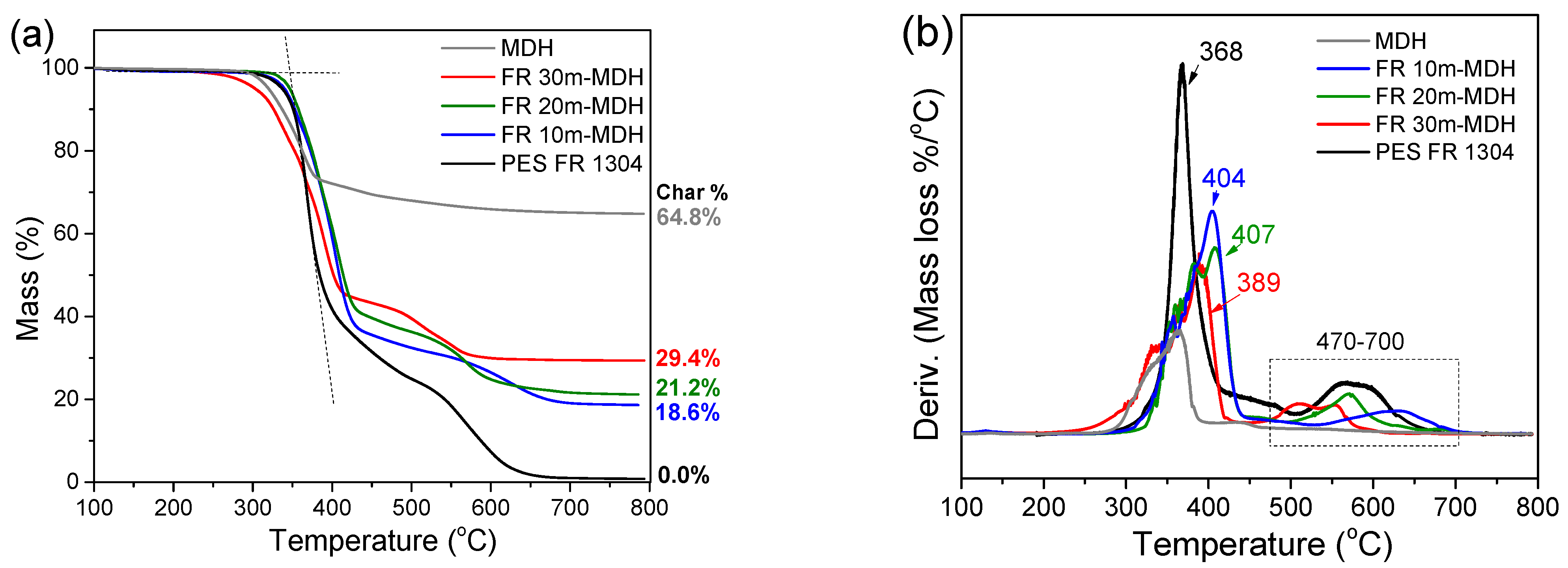
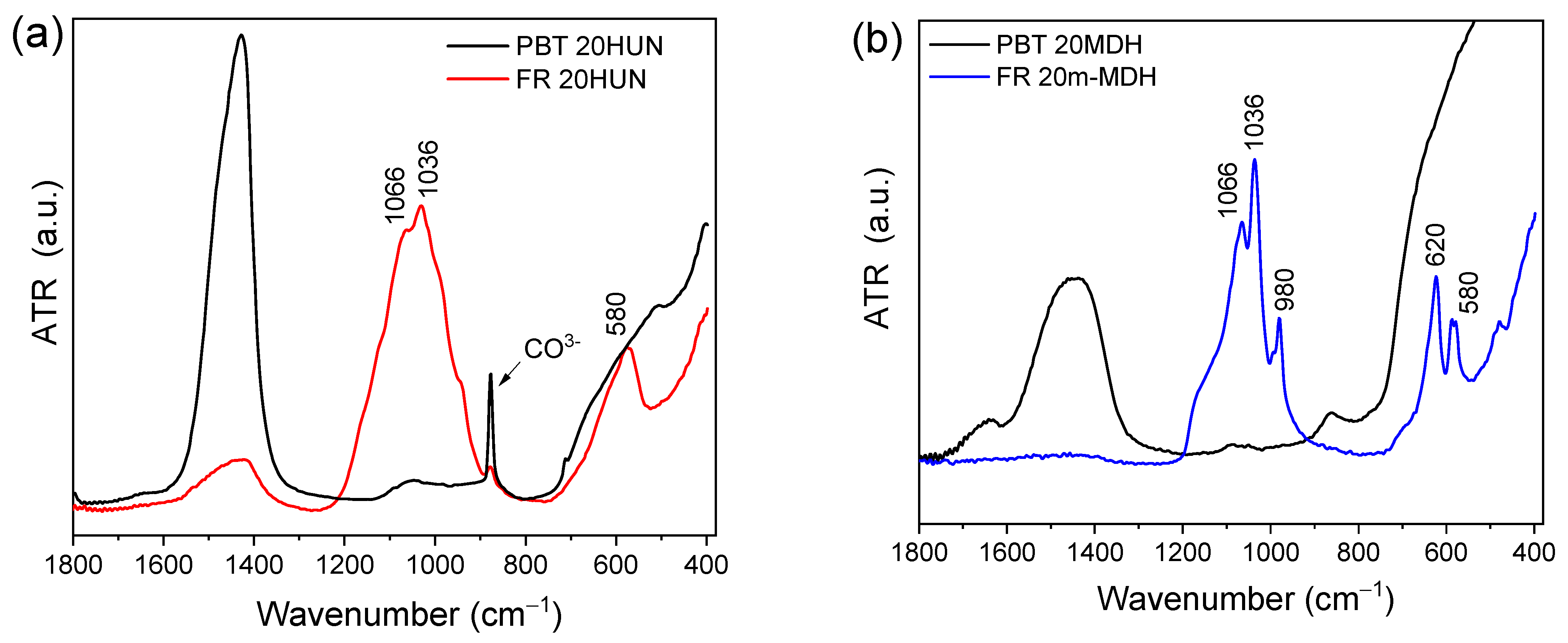

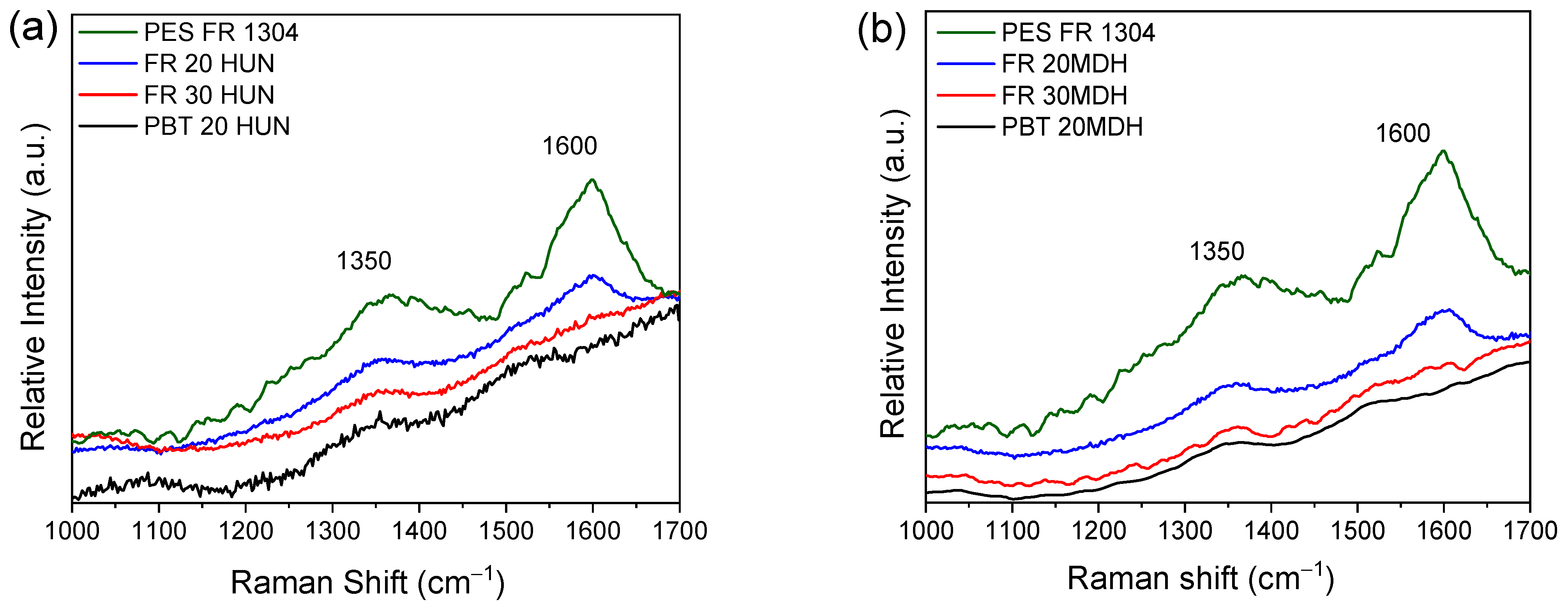

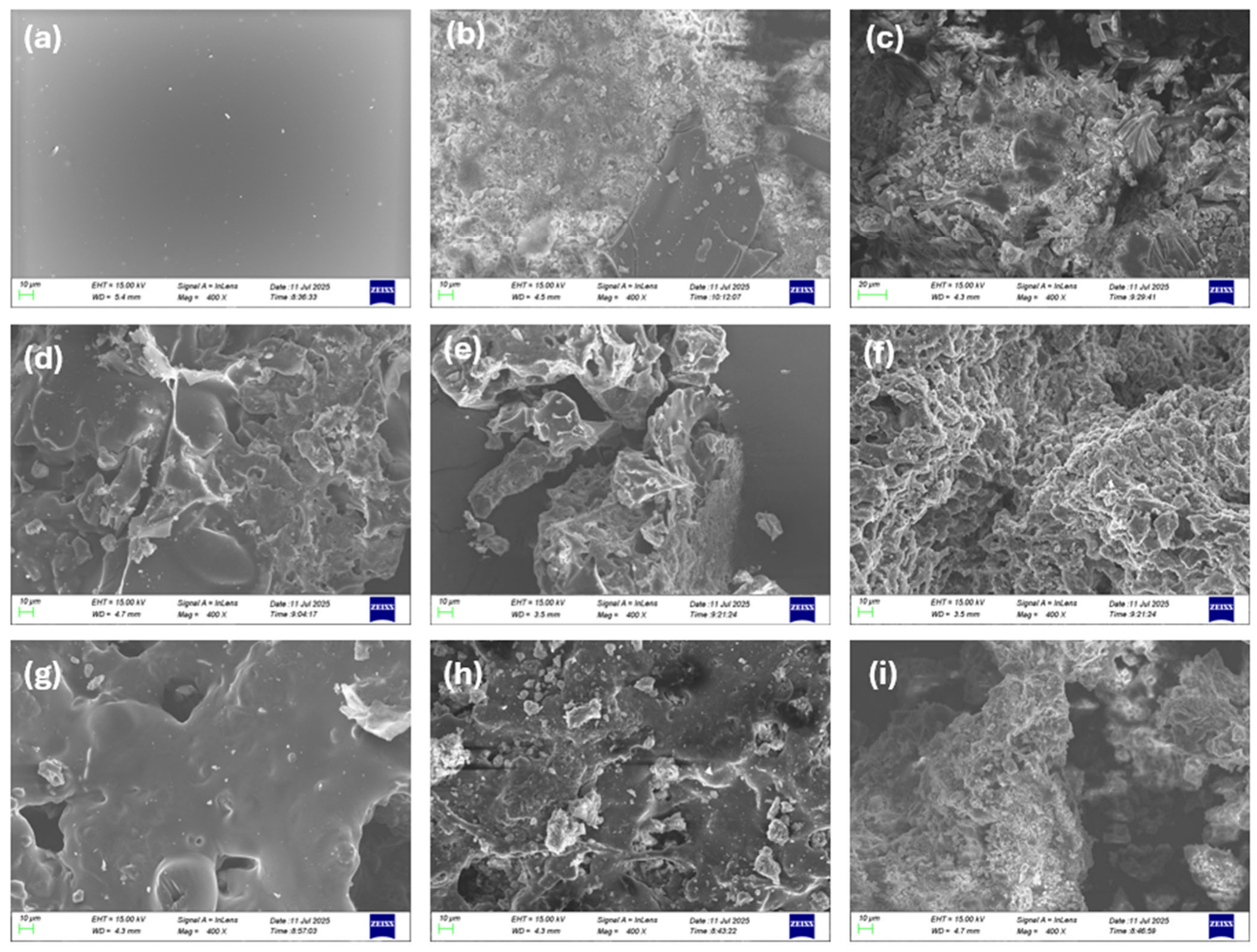
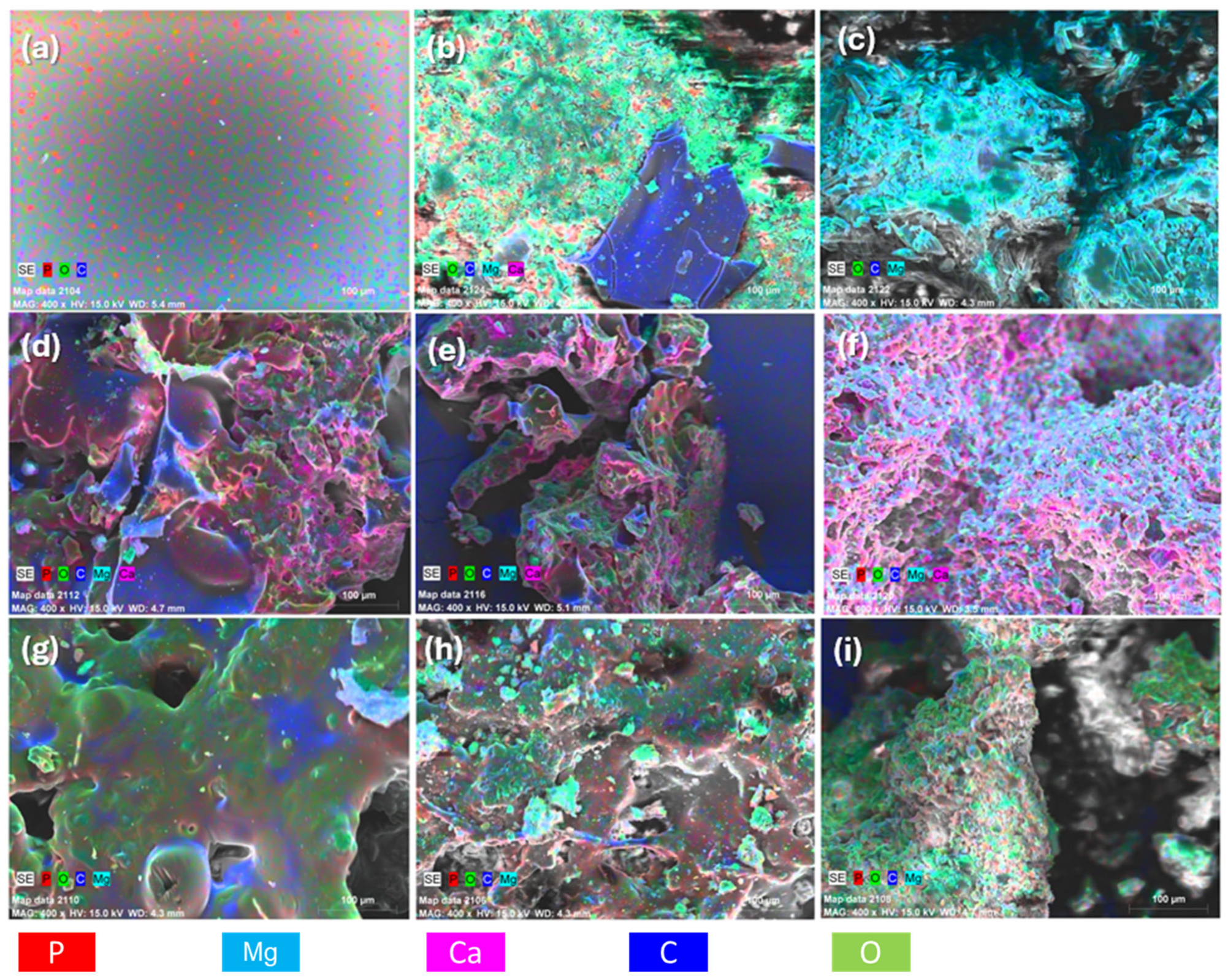
| Sample | Mg(OH)2 wt.% | Huntite wt.% |
|---|---|---|
| PES FR 1304 | - | - |
| FR 10m-MDH | 10 | - |
| FR 20m-MDH | 20 | - |
| FR 30m-MDH | 30 | - |
| FR 10HUN | - | 10 |
| FR 20HUN | - | 20 |
| FR 30HUN | - | 30 |
| PBT 20MDH | 20 | - |
| PBT 20HUN | 20 | - |
| Sample | LOI (%) |
|---|---|
| PES FR 1304 | 28.6 ± 0.0 |
| PBT | 21.3 ± 0.0 |
| FR 10m-MDH | 22.3 ± 0.0 |
| FR 20m-MDH | 23.0 ± 0.0 |
| FR 30m-MDH | 23.0 ± 0.5 |
| FR 10HUN | 23.0 ± 0.0 |
| FR 20HUN | 23.0 ± 0.0 |
| FR 30HUN | 23.0 ± 0.5 |
| PBT 20HUN | 21.3 ± 0.0 |
| PBT 20MDH | 23.0 ± 0.5 |
| Sample | Decomp. Onset (°C) | Main 1st Decomp. (°C) | Residues Yield% After 1st Decomp. | 2nd Decomp. (°C) | Residue Yield (Final)% |
|---|---|---|---|---|---|
| PES FR 1304 | 350 | 368 | 39.5 | 575 | 0 |
| PBT | 373 | 388 | 0 | - | - |
| PBT 20HUN | 367 | 395 | 37.3 | 579 | 11.5 |
| PBT 20MDH | 259 | 390 | 39.0 | 586 | 16.9 |
| FR 10HUN | 382 | 420 | 40.7 | 519 | 18.6 |
| FR 20HUN | 356 | 390 | 47.0 | 568 | 19.8 |
| FR 30HUN | 348 | 395 | 66.0 | 578 | 29.7 |
| FR 10m-MDH | 345 | 404 | 37.2 | 621 | 18.6 |
| FR 20m-MDH | 327 | 407 | 41.6 | 570 | 21.2 |
| FR 30m-MDH | 307 | 389 | 44.8 | 527 | 29.4 |
| HUN * | (235 hydr.), 368 | (392 hydr.), 542 | (91 hydr.), 63.2 | 655 | 50.9 |
| MDH | 314 | 348 | - | - | 64.8 |
| Sample | P (%) | Mg (%) | Ca (%) | C (%) | O (%) |
|---|---|---|---|---|---|
| PES FR 1304 | 1.4 | 69.4 | 29.2 | ||
| PBT 20HUN | 4.7 | 1.6 | 39 | 54.7 | |
| PBT 20MDH | 6.5 | 36.5 | 57 | ||
| FR 10HUN | 5.9 | 3.5 | 1.3 | 40.8 | 48.5 |
| FR 20 HUN | 3.7 | 2.9 | 1.2 | 44.3 | 47.9 |
| FR 30 HUN | 5.9 | 6.9 | 2.8 | 26.4 | 58 |
| FR 10m-MDH | 9 | 4.7 | 38 | 48.3 | |
| FR 20m-MDH | 9.4 | 9.7 | 27.3 | 53.6 | |
| FR 30m-MDH | 5.7 | 10.8 | 30 | 53.5 |
Disclaimer/Publisher’s Note: The statements, opinions and data contained in all publications are solely those of the individual author(s) and contributor(s) and not of MDPI and/or the editor(s). MDPI and/or the editor(s) disclaim responsibility for any injury to people or property resulting from any ideas, methods, instructions or products referred to in the content. |
© 2025 by the authors. Licensee MDPI, Basel, Switzerland. This article is an open access article distributed under the terms and conditions of the Creative Commons Attribution (CC BY) license (https://creativecommons.org/licenses/by/4.0/).
Share and Cite
Mitropoulou, E.; Mathioudakis, G.N.; Soto Beobide, A.; Porfyris, A.; Dracopoulos, V.; Kılınç, K.; Chatzinikolaou, T.; Savci, D.; Gunesoglu, C.; Kallitsis, J.; et al. A Thorough Investigation of the Mechanism of theAntagonistic Effect Between Phosphorus and Basic Oxide-Forming Minerals as Flame Retardants of PolymericComposite Coatings. Coatings 2025, 15, 886. https://doi.org/10.3390/coatings15080886
Mitropoulou E, Mathioudakis GN, Soto Beobide A, Porfyris A, Dracopoulos V, Kılınç K, Chatzinikolaou T, Savci D, Gunesoglu C, Kallitsis J, et al. A Thorough Investigation of the Mechanism of theAntagonistic Effect Between Phosphorus and Basic Oxide-Forming Minerals as Flame Retardants of PolymericComposite Coatings. Coatings. 2025; 15(8):886. https://doi.org/10.3390/coatings15080886
Chicago/Turabian StyleMitropoulou, Evangelia, Georgios N. Mathioudakis, Amaia Soto Beobide, Athanasios Porfyris, Vassilios Dracopoulos, Kerim Kılınç, Theodosios Chatzinikolaou, Deniz Savci, Cem Gunesoglu, Joannis Kallitsis, and et al. 2025. "A Thorough Investigation of the Mechanism of theAntagonistic Effect Between Phosphorus and Basic Oxide-Forming Minerals as Flame Retardants of PolymericComposite Coatings" Coatings 15, no. 8: 886. https://doi.org/10.3390/coatings15080886
APA StyleMitropoulou, E., Mathioudakis, G. N., Soto Beobide, A., Porfyris, A., Dracopoulos, V., Kılınç, K., Chatzinikolaou, T., Savci, D., Gunesoglu, C., Kallitsis, J., & Voyiatzis, G. A. (2025). A Thorough Investigation of the Mechanism of theAntagonistic Effect Between Phosphorus and Basic Oxide-Forming Minerals as Flame Retardants of PolymericComposite Coatings. Coatings, 15(8), 886. https://doi.org/10.3390/coatings15080886








